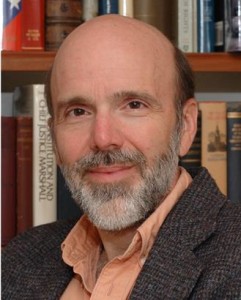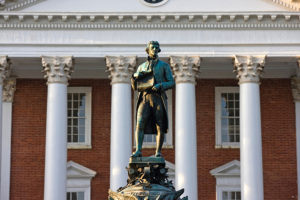Thomas Jefferson: An In-Depth Look at the Man We Have Immortalized: The Challenge of Teaching the History of American Icons
 Written by: John Ragosta, Summer Jefferson Symposium Lead Faculty; Virginia Foundation for the Humanities, Fellow
Written by: John Ragosta, Summer Jefferson Symposium Lead Faculty; Virginia Foundation for the Humanities, Fellow
Teaching history has changed a great deal in my lifetime. Of course, the fixation on dates, names, battles, and speeches went out many years ago – although it lingers in too many places like old leftovers in the fridge.
And while there is broad agreement on getting past isolated factoids, we continue to struggle with how to teach a more nuanced, a more contextualized, a more accurate history. While that type of history is far more interesting and relevant, it is also harder to understand. It seems to be always shifting a bit, requiring consideration of different perspectives, thinking of new ways to see the past, critically questioning not only sources but common assumptions and conclusions … exactly the types of things we talk about doing with a liberal arts education.
The new AP U.S. History guidelines reflect exactly these types of challenges and, as a result, often seem too ill-defined and open to criticism. It is easy enough to say that “students should learn to analyze and interpret historical facts and evidence,” but the skills involved are harder to pin-down. Students must have “the ability to identify, compare, and evaluate multiple perspectives on a given historical event in order to draw conclusions on the event …. to develop understanding of the past by making meaningful and persuasive historical and/or cross-disciplinary connections …. [and] to examine multiple pieces of evidence in concert with each other, noting contradictions, corroborations … to develop and support an argument.”
When we can achieve those goals, they promise a much richer and more relevant history, and the teachers seeking to bring them to students have my greatest respect.
The task is especially hard when dealing with “icons” of American history. Should Robert E. Lee and his horse vanish from public space – a hot topic these days in Charlottesville; how should Teddy Roosevelt’s wealth and role as a hunter inform our understanding of his treatment of national parks; should we learn as much from the anti-federalists (like Patrick Henry) as from the federalists (like James Madison and Alexander Hamilton)?
Then there is Jefferson: the man who “invented” America, who wrote what Andrew O’Shaughnessy, our first speaker at this year’s Summer Jefferson Symposium, rightly calls America’s mission statement. A more widely (and wildly) respected and more conflicted icon is hard to imagine.
How does one get students to understand the enormous contributions that Jefferson made in the Declaration and as president and elder statesman while grappling honestly with slavery, his sometimes brutal attacks on political opponents, and the use of his poetic words by some of the most violent modern criminals?
These are the issues that we hope to engage at the Summer Jefferson Symposium – turning the marble bust to a much more real and much more interesting person.
This is a wonderful opportunity for teachers to learn not only about Jefferson and teaching about that icon in their history classes, but about the importance and power of challenging, contextualizing, and questioning American history.
I hope that you will have a chance to join us in June.
ATTENTION VIRGINIA TEACHERS! For a limited time, in honor of Teachers’ Day and all you do all year long, Lifetime Learning is offering you the opportunity to spend the weekend of June 23-26, 2016 as a student at our Summer Jefferson Symposium at a discount! Contact Jen Giannini at jeng@virginia.edu no later than Monday, May 9, 2016 with your intent to register and receive $200 off the seminar fee.
- Testing, Diagnosing, and Treating Primary Aldosteronism: A Leading Cause of Hard-to-Treat Hypertension
- Life at the Top: Climate Change in Utqiaġvik, Alaska
- The Only Thing We Have to Fear is Fear Itself
- UVA Club of Tidewater: Hoos at Harbor Park
- Virtual Admitted Student Celebrations
- Virginia Club of New York: All The Beauty in the World Book Club+

